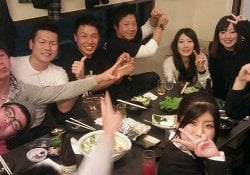The te-aru form is one of the forms that most confuses those who are new to the Japanese language, as we don't have anything that represents it in our native language. Before we delve deeper into it, let's first understand what Japanese verb forms are.
Every Japanese verb has forms or conjugations, these forms represent the state, condition, nature or moment of a given verb. The most popular form of Japanese verbs is masu.
Japanese Verbs - Dictionary Form and Masu Form
The masu form brings formality to the verb, for example the verb taberu simply means to eat, if you want to give more formality to this verb you remove the "ru" and add masu.
Example: たべる ー> たべます. In other words, you will remove one parte from the verb and add another, some verbs follow patterns when conjugated.
With that understood, let's see constructions similar to Te aru before understanding it.
Índice de Conteúdo
Post vocabulary

In this first excerpt we will see the words that will appear during this Post, so that you are already familiar with what will come next.
- 半分(はんぶん): Half
- ケーキ: Cake
- 食べる(たべる): Eat
- テレビ: Television
- 見る(みる): See
- 倉庫 そうこ - Warehouse, deposit.
- Storage; preservation
- 狭い せまい : Curto, confined, cramped.
- 空間 くうかん : Space, area.
- 物 もの, もん, モノ : Things, objects.
- 沢山 たくさん : A lot, many, much.
- アドレス: Address.
- 名刺 めいし : Carton visiting (business).
- 書く かく : To write.
particles

Now, let's familiarize ourselves with the particles that will come up during the lesson.
- の: It has the function of connecting elements, it is usually translated as: de/do/da.
Example: 彼のノート (Kare no nooto): His notebook. - を: Its function is to show the object or thing that receives the action of the verb to identify the object, it always comes before this particle.
- Example: テレビを見る (Terebi wo miru): Watch television.
Forma Te

Before continuing, we need to know the te form.
The te form is used after the verb, that is, a parte is usually removed from the verb and te is added.
Example:
- 見るー>見て (miru -> mite): eat. - (removed ru and added te)
- 食べるー>食べて (taberu -> tabete): eat - (removed ru and added te)
Te (て) - How does this form work in Japanese?
The article is still halfway through, but we recommend also reading:
Teiru

When you want to say that the action is happening, for example, in the present and continues to occur, the form teiru is used.
Let's take the following example sentence: 半分のケーキを食べている (Hanbun no keeki o tabeteiru) this phrase means: Half of the cake is being eaten.
If you want to say that it happened before, you can use the form た or ていた.
- 半分のケーキ食べた - I ate half the cake.
- 半分のケーキを食べていた - I was eating half the cake.
What changes is that the Ta form only says that it happened previously, while Teita says that it was happening before, in other words (in a progressive process). Why the progressive form? It is useful to show that the actions were in conjunction with something, for example:
- テレビを見てて、ケーキを食べていた。 - I watched television while eating cake.
Te aru

In Japanese てある, it represents the condition of permanence of an action or the consequence that remains in the face of the action. In other words, the action is carried out and its effect continues even after it has been done much earlier.
For example:
- 半分のケーキを食べてある (Half the cake was eaten) and the effect of this action remains. that is, that half that was eaten no longer exists and this fact does not change.
- 顔に嘘って書いてあるよ。 - "Lie" is written on your face. (and it remains written).
- 米は倉庫に貯蔵してある - Rice is stored in warehouses. (and it continues there).
- 狭い空間に物がたくさん置いてあるね。- There's a lot in a small space, right? (in other words, these things are still there taking up space)
- アドレスは名刺に書いてある。 - The address is in carto visit. (In other words, it remains written in the visit cartão)
Aru
We know about Te in Japanese, but what about the aru that comes right after, what does it mean?
ある Aru has the following main meanings: To have, to exist, to remain, to be located, to arise, to happen. Often confused with いる Iru which also has similar meanings, what changes is that いる is used for things that move/live. While Aru for inanimate objects.
Example:
彼女がいる He has a girlfriend. There is a girlfriend;
ビルがある There is a building.







